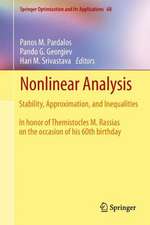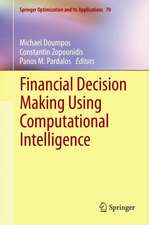Quantitative Neuroscience: Models, Algorithms, Diagnostics, and Therapeutic Applications: Biocomputing, cartea 2
Editat de Panos M. Pardalos, J. Chris Sackellares, Paul R. Carney, Leon D. Iasemidisen Limba Engleză Paperback – 31 mai 2013
| Toate formatele și edițiile | Preț | Express |
|---|---|---|
| Paperback (1) | 1093.35 lei 43-57 zile | |
| Springer Us – 31 mai 2013 | 1093.35 lei 43-57 zile | |
| Hardback (1) | 1098.48 lei 43-57 zile | |
| Springer Us – 31 ian 2004 | 1098.48 lei 43-57 zile |
Preț: 1093.35 lei
Preț vechi: 1150.89 lei
-5% Nou
Puncte Express: 1640
Preț estimativ în valută:
209.21€ • 219.02$ • 173.11£
209.21€ • 219.02$ • 173.11£
Carte tipărită la comandă
Livrare economică 07-21 aprilie
Preluare comenzi: 021 569.72.76
Specificații
ISBN-13: 9781461379515
ISBN-10: 1461379512
Pagini: 280
Ilustrații: XI, 262 p. 61 illus.
Dimensiuni: 155 x 235 x 15 mm
Greutate: 0.4 kg
Ediția:Softcover reprint of the original 1st ed. 2004
Editura: Springer Us
Colecția Springer
Seria Biocomputing
Locul publicării:New York, NY, United States
ISBN-10: 1461379512
Pagini: 280
Ilustrații: XI, 262 p. 61 illus.
Dimensiuni: 155 x 235 x 15 mm
Greutate: 0.4 kg
Ediția:Softcover reprint of the original 1st ed. 2004
Editura: Springer Us
Colecția Springer
Seria Biocomputing
Locul publicării:New York, NY, United States
Public țintă
ResearchCuprins
1 Applications of Global Optimization and Dynamical Systems to Prediction of Epileptic Seizures.- 1.1 Introduction.- 1.2 Background.- 1.3 Method and Results.- 1.4 Quadratic 0–1 Programming.- 1.5 Conclusions and Discussion.- 2 Nonlinear Neurodynamical Features in an Animal Model of Generalized Epilepsy.- 2.1 Introduction.- 2.2 Materials and Methods.- 2.3 Results.- 2.4 Discussion.- 3 Optimization Techniques for Independent Component Analysis with Applications to EEG Data.- 3.1 Introduction.- 3.2 Extraction via maximization of the absolute value of the cumulants.- 3.3 A generalization of the fixed point algorithm.- 3.4 Examples and remarks for practical implementation.- 3.5 Combining second and fourth order statistics.- 3.6 Experiment with EEG data for detection of eye movements.- 3.7 Results.- 3.8 Conclusion.- 4 On a New Quantization in Complex Systems.- 4.1 Introduction.- 4.2 A Nonlocal Correlation between Sequences.- 4.3 The Formations of Integer Relations: Processes with Integer Particles.- 4.4 Geometrization of the Integer Relations Formations.- 4.5 Quantization of States of a Complex System as the Formations of Integer Relations.- 4.6 Conclusions.- 5 The Seizure Prediction Characteristic.- 5.1 Introduction.- 5.2 The Seizure Prediction Characteristic.- 5.3 Conclusion.- 6 Seizure Prediction Methods.- 6.1 Introduction.- 6.2 EEG data and patients characteristics.- 6.3 Seizure Prediction Methods.- 6.4 Calculation of the seizure prediction characteristic.- 6.5 Results and Discussion.- 6.6 Conclusion.- 7 Controlling Neurological Disease at the Edge of Instability.- 7.1 Introduction.- 7.2 Mathematical background and outline.- 7.3 Changes in neural synchrony.- 7.4 Multistability in delayed recurrent loops.- 7.5 Noise-induced switching between attractors.- 7.6 On-offintermittency: Parametric, or state-dependent, noise.- 7.7 Self-organized criticality.- 7.8 Discussion.- 8 Anatomical Connectivity in the Central Nervous System Revealed by Diffusion Tensor Magnetic Resonance Imaging (DT-MRI).- 8.1 Fundamentals of Diffusion Weighted Magnetic Resonance Imaging.- 8.2 Diffusion Tensor Magnetic Resonance Imaging.- 8.3 Scalar Measures Derived From DT-MRI.- 8.4 Fiber-Tract Mapping in Neural Tissue.- 8.5 Problems of DT-MRI Based Fiber Tracking.- Appendix: Diffusion Tensor and Displacement Profile.- 9 Epileptic Seizure Detection Using Dynamical Preprocessing (STLmax).- 9.1 Introduction.- 9.2 Nonlinear Dynamic Preprocessing.- 9.3 Detection Methods.- 9.4 Results and Discussion.- 9.5 Conclusion and Directions for Future Work.- 10 Role Of The Dorsocentral Striatum In Contralateral Neglect And Recovery From Neglect In Rats.- 10.1. The Rodent Model of Neglect and Recovery.- 10.2 Role of the Dorsocentral Striatum in Neglect.- 10.3 Role of induced plasticity in DCS in Recovery from AGm-induced Neglect.- 10.4 Clinical Significance.- 11 Binary and Sparse Checkerboard Visual Stimuli in Multiple Sclerosis Patients.- 11.1 Methods.- 11.2 Data Analysis.- 11.3 Results.- 11.4 Discussion.- 12 Spatiotemporal Transitions in Temporal Lobe Epilepsy.- 12.1 Introduction.- 12.2 Nonlinear Dynamical and Statistical Measures.- 12.3 Results.- 12.4 Discussion.- 13 Nonlinear Dynamical and Statistical Approaches to Investigate Dynamical Transitions Before Epileptic Seizures.- 13.1 Introduction.- 13.2 Measures and Methods.- 13.3 Results.- 13.4 Discussions.- 14 Testing Whether a Prediction Scheme is Better than Guess.- 14.1 Introduction and Modeling.- 14.2 Naive Prediction Schemes.- 14.3 Testing the Hypothesis that the New Method is Better.- 14.4 An Example.- 14.5 Power Analysis.- 14.6 Concluding Remarks.- Appendix: Optimal Prediction Strategy for the Next Event.


























